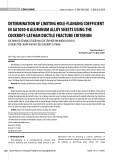
CÔNG NGHỆ https://jst-haui.vn
Tạp chí Khoa học và Công nghệ Trường Đại học Công nghiệp Hà Nội Tập 60 - Số 11 (11/2024)
110
KHOA H
ỌC
P
-
ISSN 1859
-
3585
E
-
ISSN 2615
-
961
9
DETERMINATION OF LIMITING HOLE-FLANGING COEFFICIENT
IN AA1050-O ALUMINUM ALLOY SHEETS USING THE
COCKROFT-LATHAM DUCTILE FRACTURE CRITERION
XÁC ĐỊNH HỆ SỐ NONG LỖ GIỚI HẠN CỦA TẤM HỢP KIM NHÔM AA1050-O
SỬ DỤNG TIÊU CHUẨN PHÁ HỦY DẺO COCKROFT-LATHAM
Tran Duc Hoan1,*,
To Thanh Loan2, Ta Duc Canh3
DOI: http://doi.org/10.57001/huih5804.2024.375
ABSTRACT
Hole-flanging is a crucial operation in sheet metal forming technology, where the material around a pre-
fabricated hole is deformed by a spherical, conical,
or cylindrical punch to create a flanged hole wall. This study aims to determine the limiting hole-flanging coefficient of AA1050-
O aluminum alloy sheet using
the Cockroft-Latham ductile fracture criterion. Numerical simulations of the hole-flanging process using the Cockroft-
Latham ductile fracture criterion were
conducted to identify the limiting hole-flanging coefficient of AA1050-O aluminum alloy sheet. The limiting hole-
flanging coefficient of the material was found
to be 0.61 and was further verified through experiments. Additionally, the effects of the hole-flanging coefficient on the Cockroft-Lat
ham damage value,
minimum thickness, and height of the flanged hole wall were evaluated within the formability region of the material when the
coefficient exceeded the limiting
value. The findings from this study provide valuable insights for designing hole-flanging operations for AA1050-O aluminum alloy sheet.
Keywords: Hole-flanging, ductile fracture criterion, damage, simulation, experiment.
TÓM TẮT
Nong lỗ là nguyên công quan trọng được sử dụng rộng rãi trong công nghệ tạo hình kim loại tấm, trong đó vật liệu xung quanh một lỗ được chế tạo trư
ớc bị
biến dạng bởi chày có dạng cầu, côn hoặc trụ để tạo nên thành lỗ nong. Nghiên cứu này nhằm xác định hệ số nong lỗ giới hạn của tấm hợp kim nhôm AA1050-
O
sử dụng tiêu chuẩn phá hủy dẻo Cockroft-Latham. Các mô phỏng số quá trình nong lỗ sử dụng tiêu chuẩn phá hủy dẻo Cockroft-Latham đư
ợc thực hiện để xác
định hệ số nong lỗ giới hạn của tấm hợp kim nhôm AA1050-O. Hệ số nong lỗ giới hạn của vật liệu tìm được là 0.61, được phân tích v
à xác minh thêm thông qua
các thực nghiệm. Ngoài ra, các ảnh hưởng của hệ số nong lỗ đến giá trị thiệt hại Cockroft-Latham, chiều dày tối thiểu và chiều cao của thành lỗ nong đã đư
ợc
đánh giá trong vùng khả năng tạo hình của vật liệu khi hệ số nong lớn hơn giá trị giới hạn. Những phát hiện từ nghiên cứu này cung c
ấp những hiểu biết có giá
trị cho việc thiết kế các nguyên công nong lỗ đối với các tấm hợp kim nhôm AA1050-O.
Từ khóa: Nong lỗ, tiêu chuẩn phá hủy dẻo, thiệt hại, mô phỏng, thực nghiệm.
1Faculty of Mechanical Engineering, Le Quy Don Technical University, Vietnam
2School of Materials Science and Engineering, Hanoi University of Science and Technology, Vietnam
3183 Mechanical one member limited liability company (Z183 Factory), Vietnam
*Email: tranduchoan@lqdtu.edu.vn
Received: 21/8/2024
Revised: 15/11/2024
Accepted: 28/11/2024
1. INTRODUCTION
Hole-flanging is a manufacturing process that
involves bending and stretching metal around a pre-
fabricated hole by pressing a conical, spherical, or
cylindrical punch through a die. Initially, a hole is created
by drilling or punching, after which the metal





















